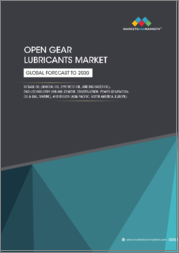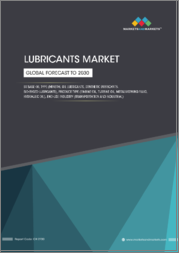
|
시장보고서
상품코드
1382504
세계의 미네랄 오일 시장(2023-2030년)Global Mineral Oils Market - 2023-2030 |
||||||
개요
세계의 미네랄 오일 시장은 2022년에 51억 달러를 기록했으며, 2023-2030년의 예측 기간 중 CAGR 4.2%로 성장하며, 2030년까지 71억 달러에 달할 것으로 예측되고 있습니다.
환경 문제에 대한 우려로 인해 미네랄 오일 시장은 보다 친환경적인 구성으로 전환하고 있습니다. 저점도 미네랄 오일은 연료 효율을 개선하고 이산화탄소 배출량을 줄이는 수단으로 인기를 끌고 있습니다. 지속가능성과 환경 인증은 점점 더 중요한 산업 촉진요인이 되고 있습니다.
대두유는 다양한 용도로 사용할 수 있으므로 지지자들은 운전 활동의 친환경성을 향상시킬 수 있다고 주장합니다. 도로 건설용 아스팔트, 전천후 타이어용 고무, 윤활유 부문에서 가장 중요한 모터 오일의 원료 등 다양한 용도로 사용됩니다. United Soybean Board의 Market View Database에 따르면 미국에서는 매년 8,900만 에이커의 콩을 재배할 수 있습니다.의 콩을 재배할 수 있으며, 약 400만 톤의 대두유이 산업용으로 전환되고 있습니다. 따라서 미국은 지역별 시장 점유율의 80.12% 이상을 차지하고 있습니다.
역학
광물성 오일의 다양한 활용
화이트 오일은 화학, 제약, 화장품 및 식품 가공 분야에서 널리 사용됩니다. 화이트 오일은 일반적으로 고도로 정제된 유연한 미네랄 오일의 일종으로 정제된 파라핀계 또는 나프텐계 원료에서 얻어지는 경우가 많습니다.
또한 고무와 플라스틱을 제조하는 산업에서도 화이트 오일이 널리 사용되고 있습니다. 폴리스티렌, PVC, 각종 고무의 합성 및 고무 제품의 연화에 필수적입니다. 플라스틱 기구와 식품 포장의 제조에도 필수적입니다. 또한 플라스틱 장난감, 연마제, 접착제, 청소용품 등에도 널리 사용됩니다. 공공의 안전이 중시되는 가운데, 화이트 미네랄 오일의 사용 범위는 지난 수십년간 지속적으로 증가하며 왔으며 앞으로도 계속 확대될 것으로 예상됩니다.
퍼스널케어 및 의약품에 대한 수요 증가
세계 미네랄 오일 시장에서는 퍼스널케어 및 의약품에 대한 수요가 그 어느 때보다 높아지고 있습니다. 미네랄 오일은 크림, 연고, 화장품 등 의약품과 퍼스널케어 제품을 전문으로 하는 로레알을 비롯한 많은 유명 브랜드의 제품에 자주 사용되는 성분입니다. 이러한 제품 수요는 여러 가지 요인에 의해 영향을 받고 있습니다. 인구 증가, 퍼스널케어 습관의 변화, 헬스케어 비용 증가 등이 미네랄 오일 시장을 지원하는 요인입니다.
또한 미네랄 오일은 피부 보습 크림의 주성분으로 사용되기도 합니다. 또한 세안과 메이크업 제거에 모두 효과적입니다. 질감을 향상시키는 스킨 케어에서 화이트 오일은 외부의 유해한 요소로부터 피부를 보호하는 경향이 있습니다. 또한 노화 방지 제품 개발에도 널리 사용되며, 특히 동아시아 및 북아시아 국가에서 높은 수요가 있습니다. 이처럼 스킨케어에 대한 투자 증가는 예측 기간 중 미네랄 오일이 성장할 수 있는 큰 기회를 창출하고 있습니다.
잠재적 건강 우려
중금속, 황 화합물 등 일부 미네랄 오일에 함유된 오염물질의 존재는 건강 문제를 야기할 수 있습니다. 오염 물질이 미네랄 오일 기반 제품에 스며들어 섭취 및 노출이 위험할 수 있습니다. 예를 들어 유럽식품안전청(EFSA)에 따르면 미네랄 오일 포화탄화수소(MOSH)는 인체에 건강 위험을 초래하지 않습니다. 또한 일부 광유 방향족 탄화수소(MOAH)는 건강에 해를 끼칠 수 있는 것으로 확인되었습니다.
환경친화적
친환경이 중요한 용도에서는 보다 친환경적이고 생분해성이 높은 바이오 및 합성 윤활유가 등장하면서 광물성 오일과 경쟁해야 하는 상황이 되었습니다. 기업의 사회적 책임의 일환으로 많은 산업에서 환경 친화적이고 지속가능한 활동을 시행하고 있습니다. 환경 친화적인 윤활유와 재료를 선택함으로써 광유 시장 확대를 저해할 수 있습니다.
사용된 광유 폐기 및 재활용은 환경에 해롭습니다. 매립지와 수역의 오염을 방지하기 위해 효과적인 폐기물 관리와 사용된 미네랄 오일의 재활용이 필요하며, 이는 미네랄 오일의 사용 비용을 증가시킬 수 있습니다. 환경 규제가 점점 더 엄격해지고 있으며, 기업은 광물성 오일의 안전한 사용과 폐기에 대해 더 높은 기준을 충족해야 합니다. 이러한 규제를 준수하는 것은 비용과 복잡성을 증가시킬 수 있습니다.
목차
제1장 조사 방법과 조사 범위
제2장 정의와 개요
제3장 주요 요약
제4장 시장 역학
- 영향요인
- 촉진요인
- 미네랄 오일의 다양한 용도
- 퍼스널케어 및 의약품 수요의 증가
- 억제요인
- 잠재적 건강 우려
- 환경에 대한 우려
- 기회
- 영향 분석
- 촉진요인
제5장 산업 분석
- Porter's Five Forces 분석
- 공급망 분석
- 가격 분석
- 규제 분석
- 러시아·우크라이나 전쟁의 영향 분석
- DMI 의견
제6장 COVID-19분석
제7장 클래스별
- 파라핀 오일
- 방향족유
- 나프텐계 오일
제8장 등급별
- 산업용 등급
- 의약품 등급
- 화장품 등급
- 식품 등급
제9장 용도별
- 윤활유
- 의약품
- 화장품과 퍼스널케어
- 전기제품
- 자동차
- 농업
- 기타
제10장 지역별
- 북미
- 미국
- 캐나다
- 멕시코
- 유럽
- 독일
- 영국
- 프랑스
- 이탈리아
- 러시아
- 기타 유럽
- 남미
- 브라질
- 아르헨티나
- 기타 남미
- 아시아태평양
- 중국
- 인도
- 일본
- 호주
- 기타 아시아태평양
- 중동 및 아프리카
제11장 경쟁 구도
- 경쟁 시나리오
- 시장 현황/점유율 분석
- M&A 분석
제12장 기업 개요
- ExxonMobil
- 회사 개요
- 제품 포트폴리오와 설명
- 재무 개요
- 주요 발전
- Royal Dutch Shell
- Chevron Corporation
- TotalEnergies
- BP
- Sinopec Group
- Nynas AB
- Repsol
- Hindustan Petroleum Corporation Limited(HPCL)
- Indian Oil Corporation Limited(IOCL)
제13장 부록
KSA 23.11.28Overview
Global Mineral Oils Market reached US$ 5.1 billion in 2022 and is expected to reach US$ 7.1 billion by 2030, growing with a CAGR of 4.2% during the forecast period 2023-2030.
As a result of environmental concerns, the mineral oil market is shifting toward more environmentally friendly compositions. Low-viscosity mineral oils are gaining popularity as a means of improving fuel efficiency and lowering carbon emissions. Sustainability and eco-certification are increasingly important industry drivers.
Because soybean oils can be utilized in a variety of applications, supporters claim that they can improve the environmental friendliness of driving activities. The uses include asphalt for road building, rubber for all-weather tires and, most importantly for the lubricants sector, base stocks for motor oils. According to United Soybean Board's Market View Database, U.S. itself can farm 89 million acres of soybeans each year and around 4 million metric tons of soybean oil is diverted to industrial purposes. Therefore, U.S. is accounting for the more than 80.12% of the regional market shares.
Dynamics
Diverse Application of Mineral Oils
White oil is widely utilized in the chemical, pharmaceutical, cosmetics and food processing sectors. White oils are usually recognized as a class of highly refined and flexible mineral oils that are often derived from refinery paraffinic or naphthenic base stocks.
Furthermore, the industries that make rubber and plastics also use white oils extensively. It is vital to the synthesis of polystyrene, PVC and various rubbers, as well as to the softening of rubber products. It is essential for making plastic utensils and food packaging. It's also widely available in plastic toys, polishes, glues and cleaning supplies. With the emphasis on public safety, the range of applications for white mineral oils is expected to continue expanding in the future, having only increased during the last few decades.
Rising Demand for Personal Care and Pharmaceutical Products
he global market for mineral oil has seen unprecedented demand for personal care and pharmaceuticals. Mineral oil is a common ingredient in many major brands' products, including Loreal, which specializes in pharmaceutical and personal care items like creams, ointments and cosmetics. The need for these goods is also influenced by a few other factors. Some of the factors supporting the mineral oil market are population growth, shifting personal care practices and rising healthcare costs.
Furthermore, mineral oil is also being as a key ingredient for skin-hydrating creams. It also works well for both cleaning and makeup removal. It enhances the texture's quality. For skin care, white oil tends to shield the skin from the damaging elements outside. It is also widely used in the development of anti-aging products, which are in high demand, particularly in the nations of East and North Asia. Thus, rising investment in skin care has created a huge opportunity for mineral oil to grow in the forecast period
Potential Health Concerns
The presence of contaminants in some mineral oils, such as heavy metals and sulfur compounds, could lead to health issues. The contaminants can seep into mineral oil-based goods and their intake or exposure can be hazardous. For instance, as per the European Food Safety Authority (EFSA), mineral oil-saturated hydrocarbons (MOSH) do not constitute a health risk to people. It also confirmed that some mineral oil aromatic hydrocarbons (MOAH) are potentially hazardous to one's health.
Environmental Concerns
In applications where environmental considerations are crucial, the advent of bio-based and synthetic lubricants, which are often more environmentally benign and biodegradable, poses a competitive challenge to mineral oils. As part of their corporate social responsibility, many industries are implementing green and sustainable practices. It may choose lubricants and materials with a lower environmental impact, stifling the expansion of the mineral oils market.
The disposal and recycling of used mineral oils are hazardous to the environment. To prevent contamination of landfills and water bodies, effective waste management and recycling of spent mineral oils are required, which might raise the cost of using mineral oils. Environmental rules have become more stringent, requiring enterprises to meet greater standards for the safe use and disposal of mineral oils. Compliance with these regulations may result in increased expenses and complexity.
Segment Analysis
The global mineral oils market is segmented based on class, grade, application and region.
Machinery Lubrication and Cost Effectiveness
Machinery lubrication is the most typical application for industrial-grade mineral oils. It is essential to guaranteeing the smooth operation of industrial equipment, decreasing friction, dissipating heat and extending machinery lifespan. The ongoing expansion of industrial sectors, fueled by globalization and technical advancements, leads to an increase in the utilization of machinery and equipment.
Lubricants, particularly industrial-grade mineral oils, are in high demand as industrial operations expand. Industrial-grade mineral oils are frequently more cost-effective than synthetic lubricants. It cost benefit is particularly enticing to firms looking to cut operational expenses while maintaining performance. Therefore, the industrial grade segment captures more than 1/3rd of the global segmental shares.
Geographical Penetration
Growing Regional Exports Drives the Asia-Pacific Market
Some of the world's largest ports and marine commerce routes are located in Asia-Pacific. For ship engines and equipment, the marine industry relies on specialist lubricants comprising mineral oils and the development in maritime traffic fuels demand for these lubricants.
According to United Nations COMTRADE database on international trade, China's exports of mineral fuels, oils and distillation products to the Philippines totaled US$ 2.79 billion in 2022. China's exports of mineral fuels, oils and distillation products to the Philippines in larger amount, therefore the China, leading exports of these products drives the growth of the Asia-Pacific mineral oils market.
COVID-19 Impact Analysis
The global outbreak of coronavirus has shown a negative impact on the growth of the lubricants market and mineral oil being a key lubricant in various industries has seen the same impact. The severity of impact varies for different end-users. Lockdowns and other measures to stop the virus's spread resulted in a sharp decline in mineral oil production and demand across numerous industries. Mineral oil sales were directly impacted by decreased manufacturing, restrictions on automobile travel and a slowdown in international trade.
The demand for products made with mineral oil hampered drastically as a result of the pandemic. Lockdowns and other restrictions reduced transportation and industrial activity, which in turn decreased demand for automotive and industrial lubricants. However, white oils are a type of mineral oil and the demand for them in medicine and pharmaceuticals increased at the same time.
Russia-Ukraine War Impact Analysis
The geopolitical and economic repercussions of the Russia-Ukraine war have had a major effect on the mineral oil market. One of the main effects on the market is price volatility. The region's geopolitical unrest has led to fluctuations in the prices of vital raw materials, including crude oil. Crude oil is the base for any lubricant production and war has a significant impact on crude oil production, consumption and transportation leading to a hamper all overall lubricant industry including mineral oil. Furthermore, Trade restrictions and sanctions brought about by geopolitical tensions made it more difficult to import and export mineral oil and related products. It could restrict access to markets and have an impact on global trade.
By Class
- Paraffinic Oil
- Aromatic Oil
- Naphthenic Oil
By Grade
- Industrial Grade
- Pharmaceutical Grade
- Cosmetic Grade
- Food Grade
By Application
- Lubricants
- Pharmaceuticals
- Cosmetics and Personal Care
- Electrical
- Automotive
- Agriculture
- Others
By Region
- North America
- U.S.
- Canada
- Mexico
- Europe
- Germany
- UK
- France
- Italy
- Russia
- Rest of Europe
- South America
- Brazil
- Argentina
- Rest of South America
- Asia-Pacific
- China
- India
- Japan
- Australia
- Rest of Asia-Pacific
- Middle East and Africa
Key Developments
- On September 6, 2022, Sitio Royalties Corp. and Brigham Minerals, Inc. have announced a definitive agreement to combine in an all-stock merger, with an aggregate enterprise value of approximately US$ 4.8 billion based on the closing share prices of STR and MNRL on Friday, September 2, 2022). The merger brings together two of the largest public companies in the oil and gas mineral and royalty sector, as well as complementary high-quality assets in the Permian Basin and other oil-focused regions, resulting in an industry leader with a proven track record of consolidating oil and gas mineral and royalty interests held by a diverse set of E&P companies.
- In October 2023, a panel of international experts informed the inaugural session of IMARC 2023 that Australia has a significant chance to contribute to the growing demand for key minerals by enhancing global supply chains and increasing strategic national collaboration.
- On May 23, 2023, Exxon acquired lithium rights as oil companies expanded into vital mineral extraction. The US$ 100 million transaction is the latest in a series of investments by oil majors in crucial resource mining.
Competitive Landscape
major global players in the market include: ExxonMobil, Royal Dutch Shell, Chevron Corporation, Total Energies, BP, Sinopec Group, Nynas AB, Repsol, Hindustan Petroleum Corporation Limited (HPCL) and Indian Oil Corporation Limited (IOCL).
Why Purchase the Report?
- To visualize the global mineral oils market segmentation based on class, grade, application and region, as well as understand key commercial assets and players.
- Identify commercial opportunities by analyzing trends and co-development.
- Excel data sheet with numerous data points of mineral oils market-level with all segments.
- PDF report consists of a comprehensive analysis after exhaustive qualitative interviews and an in-depth study.
- Product mapping available as excel consisting of key products of all the major players.
The global mineral oils market report would provide approximately 61 tables, 61 figures and 184 Pages.
Target Audience 2023
- Manufacturers/ Buyers
- Industry Investors/Investment Bankers
- Research Professionals
- Emerging Companies
Table of Contents
1. Methodology and Scope
- 1.1. Research Methodology
- 1.2. Research Objective and Scope of the Report
2. Definition and Overview
3. Executive Summary
- 3.1. Snippet by Class
- 3.2. Snippet by Grade
- 3.3. Snippet by Application
- 3.4. Snippet by Region
4. Dynamics
- 4.1. Impacting Factors
- 4.1.1. Drivers
- 4.1.1.1. Diverse Application of Mineral Oils
- 4.1.1.2. Rising Demand For Personal Care and Pharmaceutical Products
- 4.1.2. Restraints
- 4.1.2.1. Potential Health Concerns
- 4.1.2.2. Environmental Concerns
- 4.1.3. Opportunity
- 4.1.4. Impact Analysis
- 4.1.1. Drivers
5. Industry Analysis
- 5.1. Porter's Five Force Analysis
- 5.2. Supply Chain Analysis
- 5.3. Pricing Analysis
- 5.4. Regulatory Analysis
- 5.5. Russia-Ukraine War Impact Analysis
- 5.6. DMI Opinion
6. COVID-19 Analysis
- 6.1. Analysis of COVID-19
- 6.1.1. Scenario Before COVID
- 6.1.2. Scenario During COVID
- 6.1.3. Scenario Post COVID
- 6.2. Pricing Dynamics Amid COVID-19
- 6.3. Demand-Supply Spectrum
- 6.4. Government Initiatives Related to the Market During Pandemic
- 6.5. Manufacturers Strategic Initiatives
- 6.6. Conclusion
7. By Class
- 7.1. Introduction
- 7.1.1. Market Size Analysis and Y-o-Y Growth Analysis (%), By Class
- 7.1.2. Market Attractiveness Index, By Class
- 7.2. Paraffinic Oil*
- 7.2.1. Introduction
- 7.2.2. Market Size Analysis and Y-o-Y Growth Analysis (%)
- 7.3. Aromatic Oil
- 7.4. Naphthenic Oil
8. By Grade
- 8.1. Introduction
- 8.1.1. Market Size Analysis and Y-o-Y Growth Analysis (%), By Grade
- 8.1.2. Market Attractiveness Index, By Grade
- 8.2. Industrial Grade*
- 8.2.1. Introduction
- 8.2.2. Market Size Analysis and Y-o-Y Growth Analysis (%)
- 8.3. Pharmaceutical Grade
- 8.4. Cosmetic Grade
- 8.5. Food Grade
9. By Application
- 9.1. Introduction
- 9.1.1. Market Size Analysis and Y-o-Y Growth Analysis (%), By Application
- 9.1.2. Market Attractiveness Index, By Application
- 9.2. Lubricants*
- 9.2.1. Introduction
- 9.2.2. Market Size Analysis and Y-o-Y Growth Analysis (%)
- 9.3. Pharmaceuticals
- 9.4. Cosmetics and Personal Care
- 9.5. Electrical
- 9.6. Automotive
- 9.7. Agriculture
- 9.8. Others
10. By Region
- 10.1. Introduction
- 10.1.1. Market Size Analysis and Y-o-Y Growth Analysis (%), By Region
- 10.1.2. Market Attractiveness Index, By Region
- 10.2. North America
- 10.2.1. Introduction
- 10.2.2. Key Region-Specific Dynamics
- 10.2.3. Market Size Analysis and Y-o-Y Growth Analysis (%), By Class
- 10.2.4. Market Size Analysis and Y-o-Y Growth Analysis (%), By Grade
- 10.2.5. Market Size Analysis and Y-o-Y Growth Analysis (%), By Application
- 10.2.6. Market Size Analysis and Y-o-Y Growth Analysis (%), By Country
- 10.2.6.1. U.S.
- 10.2.6.2. Canada
- 10.2.6.3. Mexico
- 10.3. Europe
- 10.3.1. Introduction
- 10.3.2. Key Region-Specific Dynamics
- 10.3.3. Market Size Analysis and Y-o-Y Growth Analysis (%), By Class
- 10.3.4. Market Size Analysis and Y-o-Y Growth Analysis (%), By Grade
- 10.3.5. Market Size Analysis and Y-o-Y Growth Analysis (%), By Application
- 10.3.6. Market Size Analysis and Y-o-Y Growth Analysis (%), By Country
- 10.3.6.1. Germany
- 10.3.6.2. UK
- 10.3.6.3. France
- 10.3.6.4. Italy
- 10.3.6.5. Russia
- 10.3.6.6. Rest of Europe
- 10.4. South America
- 10.4.1. Introduction
- 10.4.2. Key Region-Specific Dynamics
- 10.4.3. Market Size Analysis and Y-o-Y Growth Analysis (%), By Class
- 10.4.4. Market Size Analysis and Y-o-Y Growth Analysis (%), By Grade
- 10.4.5. Market Size Analysis and Y-o-Y Growth Analysis (%), By Application
- 10.4.6. Market Size Analysis and Y-o-Y Growth Analysis (%), By Country
- 10.4.6.1. Brazil
- 10.4.6.2. Argentina
- 10.4.6.3. Rest of South America
- 10.5. Asia-Pacific
- 10.5.1. Introduction
- 10.5.2. Key Region-Specific Dynamics
- 10.5.3. Market Size Analysis and Y-o-Y Growth Analysis (%), By Class
- 10.5.4. Market Size Analysis and Y-o-Y Growth Analysis (%), By Grade
- 10.5.5. Market Size Analysis and Y-o-Y Growth Analysis (%), By Application
- 10.5.6. Market Size Analysis and Y-o-Y Growth Analysis (%), By Country
- 10.5.6.1. China
- 10.5.6.2. India
- 10.5.6.3. Japan
- 10.5.6.4. Australia
- 10.5.6.5. Rest of Asia-Pacific
- 10.6. Middle East and Africa
- 10.6.1. Introduction
- 10.6.2. Key Region-Specific Dynamics
- 10.6.3. Market Size Analysis and Y-o-Y Growth Analysis (%), By Class
- 10.6.4. Market Size Analysis and Y-o-Y Growth Analysis (%), By Grade
- 10.6.5. Market Size Analysis and Y-o-Y Growth Analysis (%), By Application
11. Competitive Landscape
- 11.1. Competitive Scenario
- 11.2. Market Positioning/Share Analysis
- 11.3. Mergers and Acquisitions Analysis
12. Company Profiles
- 12.1. ExxonMobil*
- 12.1.1. Company Overview
- 12.1.2. Product Portfolio and Description
- 12.1.3. Financial Overview
- 12.1.4. Key Developments
- 12.2. Royal Dutch Shell
- 12.3. Chevron Corporation
- 12.4. TotalEnergies
- 12.5. BP
- 12.6. Sinopec Group
- 12.7. Nynas AB
- 12.8. Repsol
- 12.9. Hindustan Petroleum Corporation Limited (HPCL)
- 12.10. Indian Oil Corporation Limited (IOCL)
LIST NOT EXHAUSTIVE
13. Appendix
- 13.1. About Us and Services
- 13.2. Contact Us



















